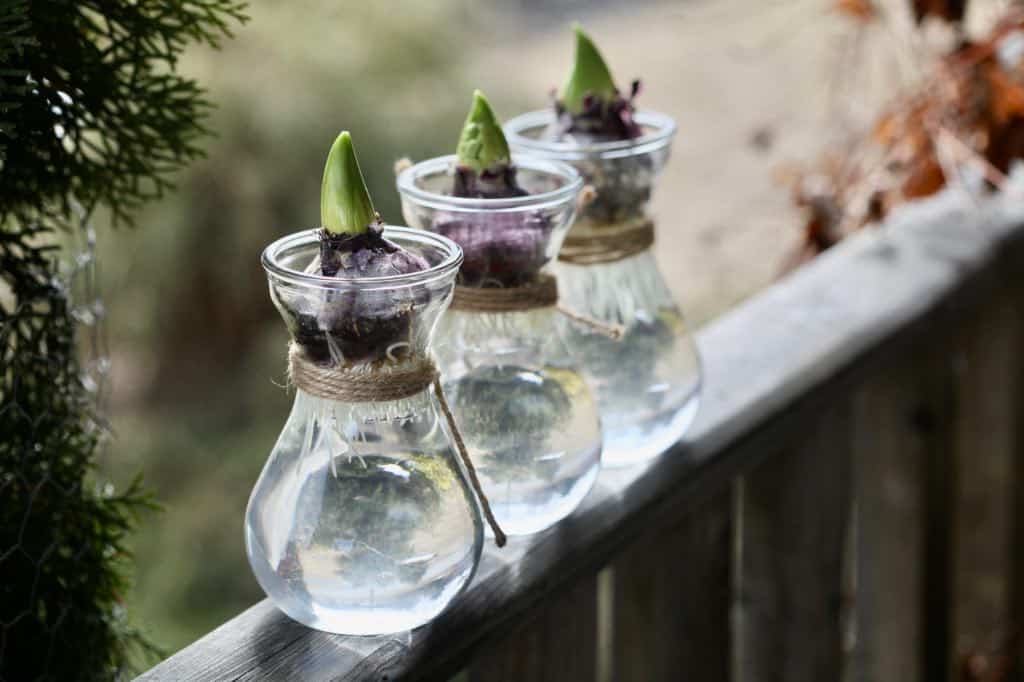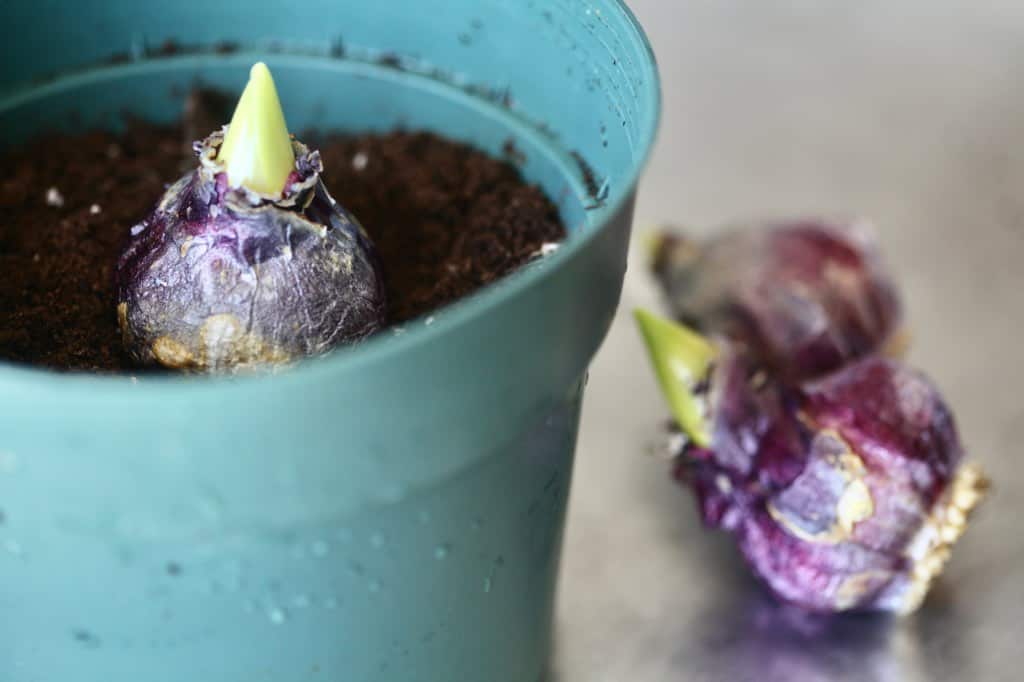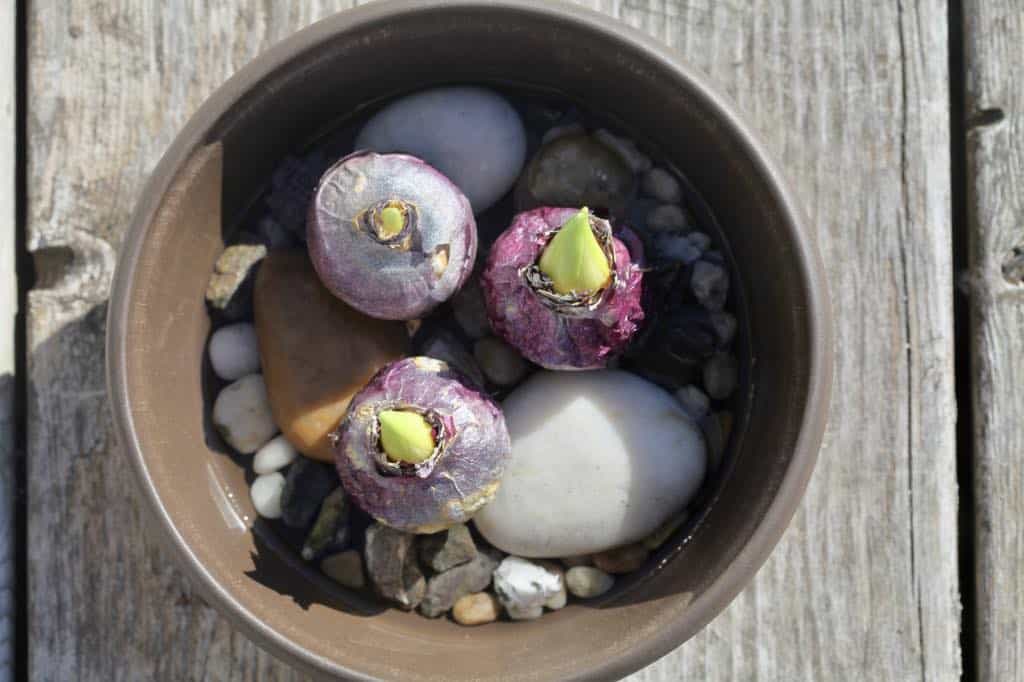Forcing bulbs is a fun way to grow flowers inside, when the rest of the garden is asleep for the winter season. The bulbs will need some special preparation in advance, and once prepared, can be brought out, to start the forcing process. Learn how to force hyacinth bulbs indoors, to grow these fragrant blooms in your indoor space.

I love to plant hyacinth bulbs in the garden in fall, for a glorious early spring display. However there's nothing like having those same blooms inside, to enjoy them in an indoor display, for the whole duration of their blooming cycle.
When hyacinths are planted out into the garden, they are grown as perennial bulbs. The bulbs bloom in spring, and then can return to the garden to enjoy year after year.
Anytime you walk by the flowers in bloom, you can catch a whiff of their wonderful scent. Plant the fragrant hyacinths close to the house so you can get to enjoy them.
When forced inside, the flowers fill your home with the wonderful fragrance of hyacinth. So be prepared for the gift of these flowers, and enjoy their beautiful blooms and sweet fragrance.
Forcing bulbs is quite easy, and once you start, you may find yourself forcing some bulbs to flower every year.

What Does Forcing Bulbs Mean?
Forcing bulbs is a process of exposing the bulbs to certain environmental conditions in order to make them bloom earlier than they would naturally do so. In a way it is manipulating the bulbs, to believe that it is spring, and time to bloom.
All sorts of bulbs can be forced to bloom, and grown indoors for a a beautiful indoor floral display.
Some examples of flowers which can be forced from bulbs include hyacinths, amaryllis, paperwhite narcissus, and tulip bulbs.
For some bulbs, the forcing process involves exposing the bulbs to certain environmental conditions, such as cold temperatures, and a dark place, which will replicate the outdoor environment. This type of forcing is done with hyacinths and tulips.

The bulbs are then exposed to warmer temperatures and a bright environment, as well as moisture, replicating the spring environment, and stimulating growth.
Other bulbs such as amaryllis will require a dormant period in a warm and dark space, prior to forcing.
Benefits Of Forcing Bulbs
Forced bulbs provide the wonderful experience of growing fresh flowers during the cold winter months, when the rest of the garden is still asleep.
The flowers offer a burst of color, and some such as early hyacinths and paper whites, have a wonderful fragrance as well.

Considerations For Forcing Bulbs
Make sure to obtain healthy bulbs for best forcing results.
Follow the specific type of forcing method which best stimulates the type of bulb which you intend to force.
If forcing hyacinth bulbs, consider wearing gloves when handling the bulbs. Many people can be allergic to direct contact with the bulbs, and the gloves will help to prevent skin irritation.

Can Hyacinth Bulbs Be Forced Indoors?
Hyacinth bulbs can be forced to grow indoors, to bloom at an earlier time than they would normally in the spring garden.
Hyacinths are some of the most popular spring bulbs for forcing indoors in winter, with their beautiful blooms and intoxicating fragrance. Forcing hyacinths is a great way to bring spring into your home, long before it arrives outside.
There are different varieties of hyacinth bulbs that can be forced to bloom indoors. These include grape hyacinth, or muscari, as well as Dutch hyacinths or hyacinth orientalis, commonly known as the garden hyacinth.
Hyacinth bulbs are hardy, and can be grown in usda hardiness zones 4 to 8.
These winter hardy bulbs have adapted to the colder growing zones, and require a dormant period in the cold for optimal blooming.
The bulbs can be grown outdoors in the garden, as well as forced to grow indoors for an earlier floral display, and I like to grow them both ways.

How Long Does It Take To Force Hyacinth Bulbs?
Forced hyacinth bulbs will need a 12 to 14 week period of cold treatment, prior to planting or placing in water. Once the bulbs have been pre-treated, they can be taken out into the warmth, and planted. Thereafter it will take another 4 to 6 weeks for the hyacinth bulbs to bloom.
Bloom time for forced bulbs depends on a number of factors.
This includes the amount of time required for the chilling period, as well as the actual time that the prepared bulbs are exposed to warmth, light and moisture after the cold treatment.
It's important to be aware of the specific guidelines of cold treatment for your variety of hyacinth.

Pre-chilled Bulbs
- Some bulbs can be purchased from garden centers with some preparation and cold treatment exposure already done. I have never been able to find them however and always start with non chilled bulbs.
- The pretreated bulbs will still need more cold treatment, however the pre treatment will reduce the required time in the cold.
- These prepared bulbs will likely have been exposed to several weeks to a month of cold temperatures. This pre treatment reduces the amount of cold treatment that the bulbs will need on your end, by the same amount.
Regular Hyacinth Bulbs
- Most places in my location only have regular, non chilled hyacinth bulbs. Make sure to purchase high quality bulbs for best results.
- Non prepared hyacinth bulbs will need a period of at least 12 to 14 weeks of cold treatment. This involves placing the bulbs in a cold and dark location for that period of time.
- The crisper drawer of your fridge is the ideal location, as long as the bulbs are not exposed to fruit. Fruit can put off an ethylene gas which may disrupt the formation of the hyacinth flower inside the bulb.
- Once the bulbs have finished their period of cold dormancy, they can be brought out into the warmth. They will then be planted in either water or soil, and will begin their growth.

Preparing The Bulbs
In order to force hyacinth bulbs indoors, the bulbs will require an extended period of cold, darkness, and moisture exposure.
The fridge is an ideal place to provide an even period of cold exposure. The best temperature for pre chilling is 35°F to 48°F.
The bulbs can be chilled separately, before planting, or can be planted, and chilled in the planting medium.
I generally chill the bulbs only, for easier storage options, however others may find it easier to do it the other way.
Chilling The Bulbs
- To provide this period of cold storage, keep the bulbs in the ventilated bag in which they were purchased, or you can also us brown paper bags as well. Place the bulbs in the bags, into the crisper drawer in the fridge.
- Remember not to store fruit in the fridge drawer with the bulbs. Ethylene gas produced by the fruit can cause damage to the developing flowers.
- The bulbs can also be placed in a cool place like a cool room, cold frame, unheated garage, or a cold basement.
- Towards the end of the chilling period, you may notice that some of the bulbs have already started to sprout.

Chilling Bulbs Planted In A Pot
- An alternate way for pretreating the hyacinth bulbs is to plant them up, and then to expose them to the cold period planted in potting medium.
- This helps to provide some moisture, along with the darkness and chill.
- If doing this method, you will likely need to find a different location for storage other than the fridge.
- Plant bulbs root end down, into a small pot with good drainage. Use a good potting medium. Cover the bulbs with 1 inch of the potting soil, and water in.
- The pot should be placed in a cool spot in a dark area for 13 weeks. Give the pot a little splash of water from time to time.
- To force the hyacinth bulbs, remove the pot from the dark location, and bring out to a cool area with indirect sunlight, until the flower stems are showing some color on the buds.
- Then move the pot to a warm location and bright spot, such as a sunny window.
- Once in full bloom, move to a bright location with indirect light, for longest flowering.

How To Force Hyacinths Indoors
This section applies to planting the chilled hyacinth bulbs, after the cold treatment period is complete. If you have already planted the bulbs in a pot and given them a cooling period in the planted state, see the above section for next steps.
Once the hyacinth bulbs have received their cold treatment, they can be removed from cold storage, and be potted up.
The bulbs can be planted in either water or a potting mix, and both methods will work great.
Forcing Hyacinths In Pots
- To force hyacinth bulbs in soil, choose a shallow pot approximately 4 to 6 inches deep, with good drainage holes.
- Fill the pot with a good potting soil.
- Place the bulbs in the pot, covering them with approximately an inch of the soil.
- Water them in.




- Place the planted pot into a cool location in indirect sunlight. Wait until the bulbs produce flower stems, and the flower buds begin to show some color.


- Once you see evidence of color, place the pot in a warmer and sunnier location, and enjoy the beautiful blooms.
- When the hyacinths are in full bloom, move to an area with indirect light, as direct sunlight can reduce the length of the bloom time.

Forcing Hyacinths In Water
- To force hyacinth bulbs in water, choose a planting container with no drainage holes. This can be a wider bulb pot, or specially designed bulb vases with a narrow neck, for holding bulbs, called forcing jars.



- If placing in a pot, fill the bottom with pebbles.
- Place the hyacinths on top of the pebbles. If using a forcing vase, place the bulb in the vase.
- Add water to the pot or vase.
- Make sure to add barely enough water to just reach the base of the bulb in the vase, and the bottom of the bulbs in the pot. If you add too much water and cover the bulbs they may rot.
- The roots will grow down, into the water. Make sure to maintain the water level as it is depleted.





- Place in a cool area, in indirect light, while the roots grow and develop. The bulbs should remain in this location until the flower buds form, and then begin to show some color.
- At this point, the bulbs can then be moved to a warmer and sunny location.
- Rotate the pot or glass vases, if the stem starts to bend towards the light. This will help with a more upright flower stem.

Frequently Asked Questions
Can the Forced Hyacinth Bulbs Be Planted Into The Garden In Spring?
Hyacinth bulbs forced in water are usually treated as annuals, and discarded after blooming.
The hyacinth bulbs which have been forced and grown in soil however, can be transplanted into the garden in spring.
Wait until the risk of frost has passed however, before planting out. Know your last spring frost date to be on the safe side, and plant out after this date.
When the plants have finished blooming, care for them inside, as you would any other indoor plants. Allow the blooms to fade and the flower stalk to wither.
Then cut the flower stalk back, and continue to provide water as needed, while the leaves remain green. Do not overwater, making sure to water only when the soil surface feels dry to the touch.
Allow the leaves to continue to grow, as they are providing energy to the bulb for it's next blooming period.
The leaves will eventually fade away as well, as the bulbs begin to go dormant. This is a normal occurrence, and is part of the plant's next growing cycle, which is a dormant period.
If the plant goes dormant before planting out, just place it in a cool and dark location.
In spring, plant out into the garden when the weather warms up and it is safe for planting. Maintain the same soil surface level in the garden, as existed in the pot indoors.
The following year the bulbs may not bloom, however the year after that, they will likely bloom during the normal spring bloom time.

How Long Do Hyacinth Flowers Last?
Growth of the hyacinth flower stem and leaves begins shortly after planting. Blooming of the flower spikes occurs within 4 to 6 weeks after the initial growth. Hyacinth flowers can last for 1 to 2 weeks in full bloom, depending on proper plant care. Forced bulbs started inside, in a cool location and in indirect lighting initially, will likely have best bloom longevity.

What Causes The Allergic Reaction To Hyacinth Bulbs?
Many bulb are known to cause a skin irritation, or bulb dermatitis, including hyacinth bulbs. The cause of the irritation is cultivar dependent.
For hyacinths, almost everyone who handles the bulbs with bare skin will have a reaction to the contact.
This reaction includes skin itching, which is caused by contact with calcium oxalate crystals.
Wearing gloves when handling the hyacinth bulbs will help to protect against this skin reaction.
Conclusion
Hyacinth flower bulbs can be forced, and grown inside, to produce earlier fresh blooms than they would produce in the garden. With a little patience, you can have a wonderful indoor display.
It's a wonderful way to bring spring indoors, when the snow is still on the ground.
These beautiful hyacinths make a lovely pairing with forced flower branches. Branches such as forced quince and magnolia branches also bring spring indoors, just a little sooner.

Have you ever tried to force hyacinth bulbs? Be sure to leave a comment below to share your experience!
Other Posts You May Like:
PIN IT FOR LATER!










Leave a Reply